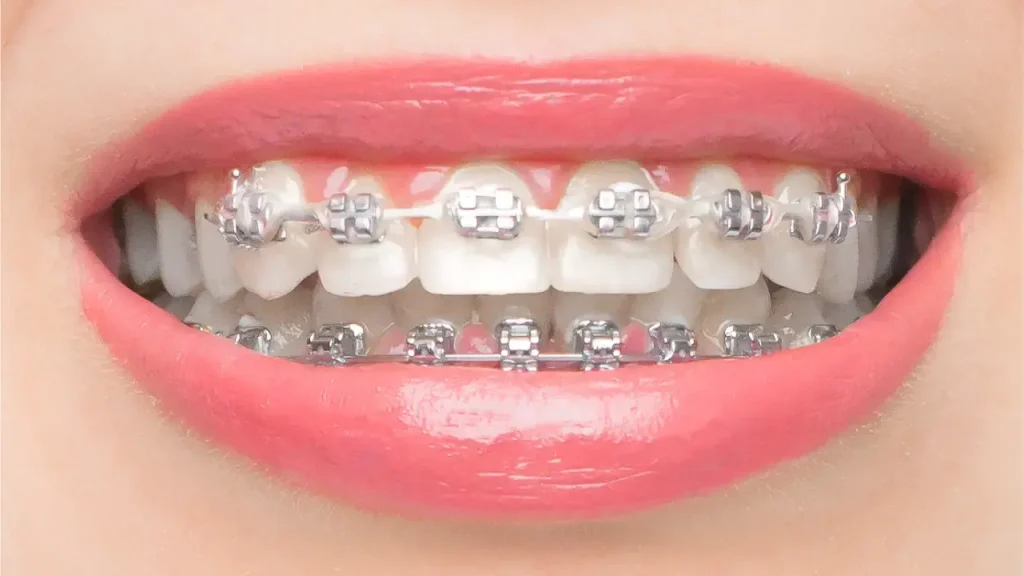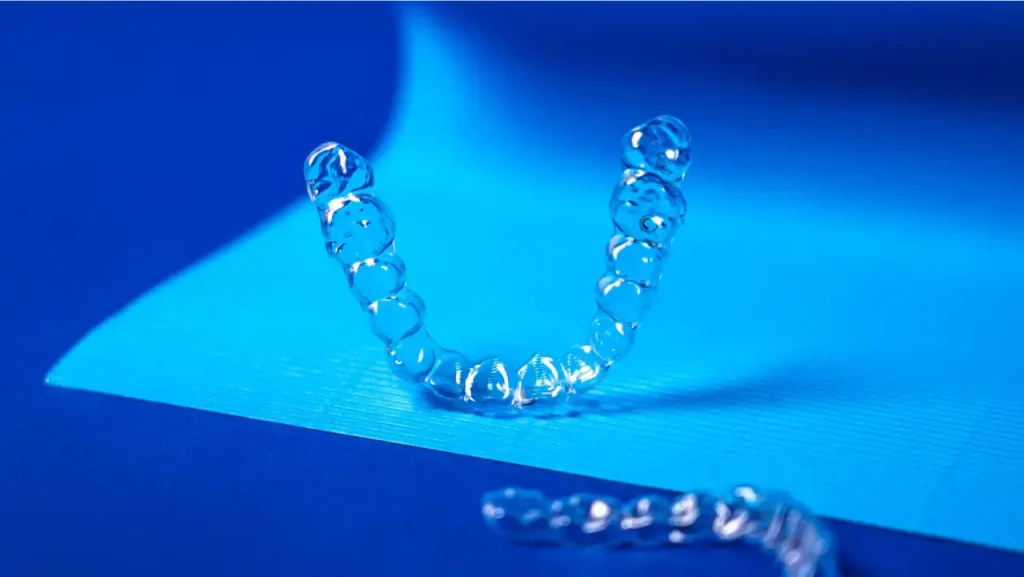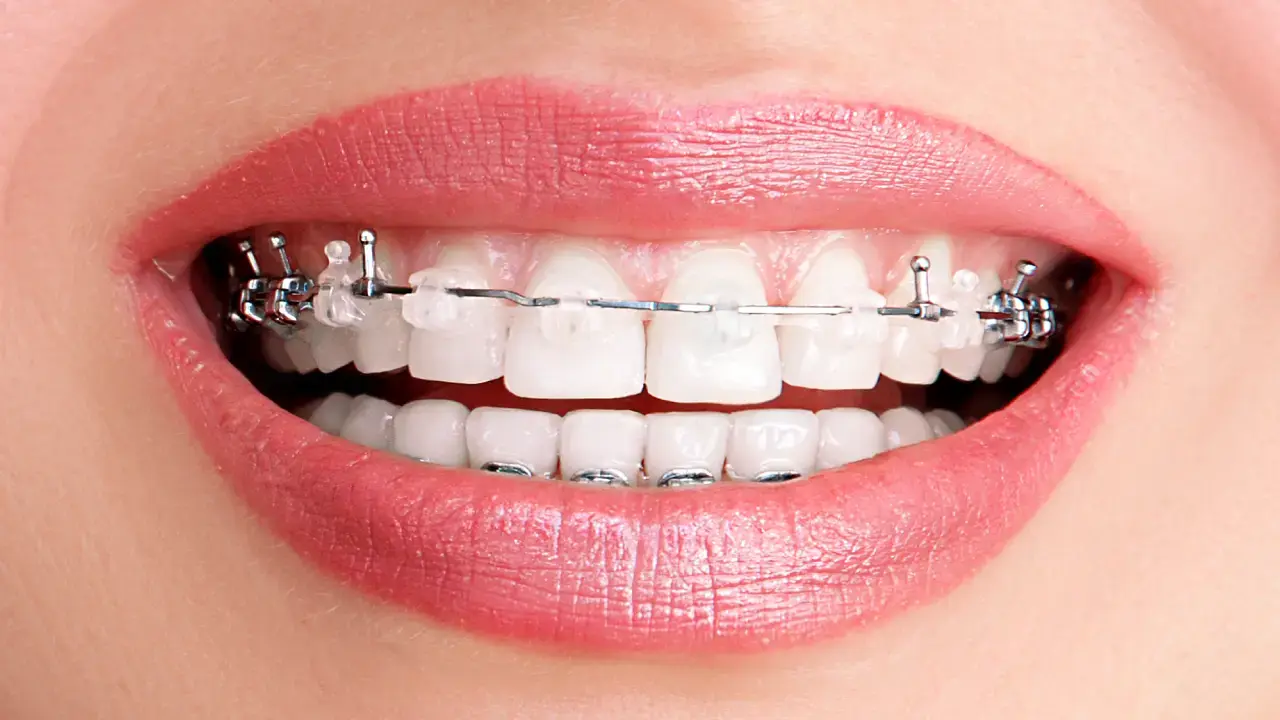Find yourself looking up self-ligating braces and wondering if they’re right for you? You’re in the right place! In this blog, we’ll break down everything you need to know about these braces — from how they work to why they’re different from traditional options.
By the end, you’ll have a clear understanding of whether self-ligating braces are the right fit for you. Ready to dive in? Let’s get started!
What are self-ligating braces?
So, what exactly are self-ligating braces (or otherwise known as Damon Braces)? Think of them as an upgraded version of traditional braces. Instead of the rubber bands you usually see on braces, self-ligating braces have a clever built-in mechanism—a tiny sliding door or clip—that holds the wire in place. This design lets the wire move around more freely, which can make the whole process of straightening your teeth a bit smoother and more comfortable. It’s like getting all the benefits of braces but with a little extra convenience!
Who are self-ligating braces for?
Wondering if self-ligating braces are right for you? They could be a great fit If comfort is high on your priority list, you might appreciate the lower friction and pressure that come with self-ligating braces.
They’re suitable for both adults and teens and are especially handy for those who’d prefer fewer trips to the orthodontist since they don’t need as many adjustments. Whether your orthodontic needs are mild or complex, your dentist can help you decide if this option is the best way to achieve that smile you’re aiming for.
What conditions can self-ligating braces treat?
Self-ligating braces are versatile and can address a variety of dental issues. They’re effective for treating:
- Crowding: When there isn’t enough space in your mouth for all your teeth, causing them to overlap or twist. Self-ligating braces help by gradually creating space and aligning your teeth properly.
- Spacing: If you have gaps between your teeth, self-ligating braces can close these spaces by gently moving the teeth closer together.
- Misalignment: Whether your teeth are slightly out of line or significantly crooked, self-ligating braces work to bring them into a straighter, more aesthetically pleasing position.
- Bite Issues: Self-ligating braces can also help correct problems with your bite, such as overbite, underbite, or crossbite, by adjusting the position of your teeth and jaws.
Self-ligating braces cost in Singapore
When exploring orthodontic options, self-ligating braces often stand out for their comfort and efficiency. But how do they compare in terms of cost?
Understanding where they fall on the price spectrum can help you decide if they’re the right choice for you. To give you a clearer picture, here’s a quick comparison of how the cost of self-ligating braces stacks up against other popular types of braces in Singapore.
Types of braces | Estimated cost |
Self-ligating braces | Usually between $4,000 to $6,000* |
Traditional metal braces | Usually between $3,000 to $6,000* |
Ceramic braces | Usually between $4,500 to $6,500* |
Invisible braces | Usually between $6,000 to $8,000* |
ZenyumClear™ | $2,790 |
ZenyumClear™ Plus | $4,490 |
ZenyumClear™ Extra | $5,090 |
*The listed prices are meant to be taken as a guide at the time of publication. Prices may be subject to prevailing GST and service charge (if any).
Types of self-ligating braces

When you’re exploring your options for self-ligating braces, it’s useful to know that there are two main types: passive and active self-ligating braces. Each type offers distinct advantages depending on where you are in your orthodontic journey and the specific needs of your treatment.
Passive self-ligating braces
Passive self-ligating braces are designed with smaller brackets and minimal friction. They allow the wire to move freely within the brackets, which can make the initial stages of treatment more comfortable. Because these braces create less resistance, they’re often used early in treatment to start aligning the teeth smoothly.
Active self-ligating braces
Active self-ligating braces feature a clip mechanism that actively presses against the wire. This design creates more pressure on the teeth, which can be effective for moving them into their desired positions more quickly. Active braces are typically used later in the treatment process when more precise adjustments are needed for optimal results.
Passive vs active self-ligating braces
Here’s a closer look at how passive and active self-ligating braces differ for easier understanding:
Feature | Passive self-ligating braces | Active self-ligating braces |
How they work | Smaller brackets with minimal friction; wire moves freely. | Clip mechanism that applies pressure to the wire. |
Initial comfort | Generally more comfortable initially due to less friction. | May feel tighter or apply more pressure initially. |
Treatment phase | Ideal for early stages of treatment for smooth alignment. | Generally used later for precise adjustments and faster progress. |
Pressure on teeth | Lower pressure, allowing for smoother initial movements. | Higher pressure, which can lead to quicker adjustments. |
Comfort level over time | May remain more comfortable due to consistent low friction. | Comfort can vary; may need more adjustments as pressure changes. |
Frequency of adjustments | Generally requires fewer adjustments due to minimal friction. | May need more frequent adjustments due to active pressure. |
Efficiency in aligning teeth | Good for starting alignment; may require additional adjustments later. | Often more efficient for complex movements and specific positioning. |
Best suited for | Best for initial alignment and minimal resistance. | Suited for complex cases needing precise and accelerated tooth movement. |
How do self-ligating braces work?
Now that you have an idea of what self-ligating braces are, you might be trying to picture how self-ligating braces will work on your smile. The secret lies in how they apply pressure to move your teeth.
Unlike traditional braces, where the orthodontist often needs to adjust the elastic bands, self-ligating braces use those built-in clips to make gentle adjustments over time.
This continuous pressure guides your teeth into their new positions, which not only reduces the need for frequent visits to the orthodontist but can also speed up the treatment process. Plus, with less friction involved, some people find the whole experience to be a lot more comfortable.
Self-ligating braces process
Understanding how self-ligating braces work can help you feel more confident about your orthodontic journey. Here’s a quick overview of what to expect from the initial consultation to the final stages of treatment:
- Initial Consultation and Planning: The process begins with an initial consultation where your orthodontist evaluates your teeth using X-rays, photographs, and impressions. Based on this assessment, a treatment plan is created, and the appropriate type of self-ligating braces is selected.
- Placement of Brackets: During your next appointment, your teeth are cleaned and dried. The orthodontist applies adhesive to each tooth and positions the self-ligating brackets. Once the brackets are securely in place, the archwire is threaded through the clips or doors in the brackets, which hold it without the need for elastic bands.
- Archwire Insertion and Adjustment: The archwire exerts pressure on your teeth to move them into position. At regular check-ups, the orthodontist will adjust the wire as needed. Self-ligating braces typically require fewer adjustments because the friction is reduced.
- Teeth Movement: As the archwire applies pressure through the clips or doors, your teeth gradually shift into their correct positions. This system helps achieve smooth and efficient movement due to its reduced friction.
- Final Stages and Removal: Once your teeth have reached their desired positions, the orthodontist will remove the brackets and clean off any remaining adhesive. To maintain your new smile, retainers will be provided to keep your teeth in their new positions.
Pros and cons of self-ligating braces
Before you decide if self-ligating braces is the right option for you, understanding the pros and cons is vital. Here’s a breakdown of the key benefits and potential disadvantages to consider:
Advantages of self-ligating braces
Reduced Friction: Self-ligating braces use clips instead of elastic bands, which means less friction. This makes adjustments more comfortable and helps teeth move smoothly.
Fewer Adjustments: With less friction, these braces usually need fewer adjustments. That means fewer trips to the orthodontist and a smoother treatment process.
Improved Hygiene: No elastic bands to trap food or plaque makes self-ligating braces easier to clean, helping you keep your smile fresh and healthy.
Faster Treatment: The smooth movement and reduced friction can sometimes speed up your treatment time, though this varies from person to person.
More Aesthetic Options: You can choose from ceramic or clear self-ligating braces, which are less noticeable than traditional metal ones for a more discreet look.
Disadvantages of self-ligating braces
Initial Discomfort: Self-ligating braces are usually more comfortable, but you might feel some initial discomfort as they start moving your teeth.
Cost: They can cost more than traditional braces because of the advanced tech and materials involved.
Limited Application: For some complex issues, traditional braces or other devices might be better suited, so self-ligating braces might not always be the best option.
Complex Repairs: If something goes wrong with a bracket or the clip mechanism, repairs can be trickier and may take more time.
Availability: Not every orthodontist offers self-ligating braces, so you might need to find a specialist who does.
Comparison between Self-ligating braces and other methods
To help you make an informed decision, here’s a quick comparison of these braces options to guide you in choosing the right braces for your needs and preferences:
Features | Self-ligating braces | Invisible braces | Traditional metal braces | Ceramic braces |
Appearance | Less noticeable, smaller brackets, no elastic bands | Virtually invisible, clear aligners | More visible, traditional metal look | Blends with teeth color, less noticeable than metal |
Comfort | Reduced friction, generally more comfortable | Highly comfortable, smooth aligners, no brackets | Can cause discomfort due to elastic bands | Comfortable, but friction may be higher than self-ligating |
Maintenance | Easier to clean, fewer adjustments needed | Removable for easy cleaning, no food restrictions | Requires frequent adjustments, can trap food | Prone to staining and breakage, more maintenance needed |
Durability | Durable, fewer adjustments, robust design | Durable but needs care, can be damaged if mishandled | Highly durable but can cause irritation | Less durable, prone to staining and breaking |
If you would like to go more in depth about other possible options, check out our guide on all you need to know about the different types of braces to find your right fit.
Self-ligating braces vs invisible braces

When comparing self-ligating braces with invisible braces, both options have their own unique advantages, depending on your orthodontic needs and lifestyle preferences:
- Appearance: Invisible braces are clear and nearly unnoticeable, ideal for those seeking a discreet option. Self-ligating braces are more visible, though ceramic versions can blend with your teeth for a subtler look.
- Comfort: Invisible braces are custom-made to fit your teeth comfortably. Self-ligating braces also aim to reduce discomfort with less friction compared to traditional braces.
- Removability: Invisible braces can be removed for eating and cleaning, offering convenience and easier maintenance. Self-ligating braces are fixed, requiring more diligence in keeping them clean.
- Adjustment needs: Invisible braces typically require fewer orthodontic visits, as you change the aligners regularly at home. Self-ligating braces also need fewer adjustments than traditional braces, but you’ll still have periodic check-ups.
Zenyum Invisible Braces

If discreet appearance, comfortable fit, and the convenience of removability is what you’re looking for, consider giving Zenyum Invisible Braces a go. With fewer visits to the orthodontist and a treatment process that fits seamlessly into your lifestyle, Zenyum Invisible Braces could be the ideal choice for achieving your dream smile. All you need is five minutes to know if Zenyum is your best fit.
Self-ligating braces vs traditional metal braces
When choosing between self-ligating and traditional metal braces, it’s essential to consider how each impacts your comfort, appearance, and daily maintenance.
- Appearance: Self-ligating braces are less noticeable than traditional metal braces. Their smaller brackets and the absence of elastic bands make them a subtler option. Metal braces are more visible and have a classic, traditional look.
- Comfort: Self-ligating braces generally offer more comfort with less friction, reducing irritation compared to metal braces, which can sometimes cause discomfort due to the elastic bands.
- Maintenance: Metal braces require regular adjustments and can trap food easily, making them trickier to keep clean. Self-ligating braces, with their clip mechanism, are easier to clean and typically require fewer adjustments.
Self-ligating braces vs ceramic braces
If aesthetics are a priority, you might be weighing self-ligating braces against ceramic braces. Here’s how they stack up in terms of appearance, comfort, and durability.
- Aesthetic Appeal: Ceramic braces are designed to match the color of your teeth, making them less noticeable than metal braces but still visible. Self-ligating braces also come in ceramic options, offering a less conspicuous look compared to metal, though not as invisible as clear aligners.
- Comfort: Both ceramic and self-ligating braces aim for comfort, but self-ligating braces may have the upper hand with reduced friction and fewer adjustments.
- Durability and Maintenance: Ceramic braces are more prone to staining and breakage, which can make maintenance more challenging. Self-ligating braces are generally more durable, with fewer adjustments needed, making them a reliable option.
Choosing the right braces that is suitable for you
Self-ligating braces offer a blend of comfort, efficiency, and modern orthodontic technology, making them a popular choice for many. With fewer adjustments, easier maintenance, and the potential for shorter treatment times, they present a compelling option. However, as with any orthodontic treatment, it’s important to consider your specific needs, lifestyle, and budget.
If you’re leaning towards a more discreet option or want the flexibility of removability, you might also want to explore alternatives like invisible braces. Ultimately, the best choice will depend on your individual situation and what you prioritize most in your treatment.

Ready to take the next step?
Explore how Zenyum Invisible Braces can be the right fit for you.
FAQs on self-ligating braces
How long do self-ligating braces take?
The duration of treatment with self-ligating braces can vary depending on your specific dental needs, but generally, it takes anywhere from 18 to 24 months. Some people might see results a bit sooner, especially since self-ligating braces are designed to reduce friction and help teeth move more efficiently. However, keep in mind that everyone’s teeth are different, so your orthodontist will give you a more accurate timeline based on your individual case.
How do I know if I need self-ligating braces?
Deciding if self-ligating braces are right for you depends on several factors, like your comfort preferences, the complexity of your dental issues, and your lifestyle. If you’re looking for a treatment option that requires fewer adjustments and is easier to clean, self-ligating braces might be a good fit. However, the best way to know for sure is to have a chat with your orthodontist. They’ll assess your teeth and recommend the best treatment plan for your needs.




